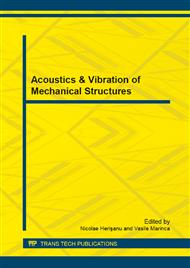[1]
R. Bannister. Determination of Machinery Foundation Vibration Transmission with Impedance Techniques Applied to Plastic Models, J. Acoust. Soc. Am., 51: 1A (1972) 99-99.
DOI: 10.1121/1.1981741
Google Scholar
[2]
Y. Qiu, M. J. Griffin, Transmission of vibration to the backrest of a car seat evaluated with multi-input models, Journal of Sound and Vibration, 274: 1–2 (2004) 297–321.
DOI: 10.1016/j.jsv.2003.05.015
Google Scholar
[3]
Y. Qiu, M. J. Griffin, Transmission of roll, pitch and yaw vibration to the backrest of a seat supported on a non-rigid car floor, Journal of Sound and Vibration, 288: 4–5 (2005) 1197–1222.
DOI: 10.1016/j.jsv.2005.01.029
Google Scholar
[4]
W. Rockwood, Study of ground effects on building foundation vibration using two-dimensional real-mode finite element analysis, Proc. SPIE 1619, Vibration Control in Microelectronics, Optics, and Metrology, 228 (1992).
DOI: 10.1117/12.56842
Google Scholar
[5]
ISO 16063-1: 1998, Methods for the calibration of vibration and shock transducers - Part 1.
Google Scholar
[6]
C. Veldman, ISO 16063 - a comprehensive set of vibration and shock calibration standards, XVIII IMEKO World Congress, Metrology for a Sustainable Development, 2006, Rio de Janeiro.
Google Scholar
[7]
G. Ripper, R. Dias, G. Garcia, Primary accelerometer calibration problems due to vibration exciters, Measurement, 42: 9 (2009) 1363–1369.
DOI: 10.1016/j.measurement.2009.05.002
Google Scholar
[8]
T. Usuda and T. Kurosawa, Calibration methods for vibration transducers and their uncertainties, Metrologia, Vol. 36: 4 (1999) 375-83.
DOI: 10.1088/0026-1394/36/4/17
Google Scholar
[9]
N. H. Clark, First level calibrations of accelerometers, Metrologia, Vol. 36: 4 (1999) 385-389.
DOI: 10.1088/0026-1394/36/4/18
Google Scholar
[10]
B. Payne, D. J. Evans, Comparison of results of calibrating the magnitude of the sensitivity of accelerometers by laser interferometry and reciprocity, Metrologia, 36: 4 (1999) 391-394.
DOI: 10.1088/0026-1394/36/4/19
Google Scholar
[11]
N. Orăşanu, A. Craifaleanu, Theoretical and experimental analysis of the vibrations of an elastic beam with four concentrated masses, Proc. SISOM 2011, Bucharest (2011) 471-480, http: /www. imsar. ro/SISOM%20_Papers_2011/A08. pdf.
Google Scholar
[12]
S. Graham Kelly, Mechanical Vibrations: Theory and Application, Cengage Learning, USA, (2012).
Google Scholar


